Understanding art periods means exploring a timeline that highlights the evolution of styles from the Renaissance's realism to contemporary art's focus on identity and politics. Each period showcases unique characteristics influenced by cultural and historical contexts. For instance, Impressionism captured light effects, while Dadaism challenged established norms. As you trace these movements, you'll uncover how they reflect societal values and interconnect with one another. Familiarizing yourself with key artists and their notable works enhances your appreciation of art. Keep going to discover tips, resources, and deeper insights into how these periods shape our understanding of artistic expression.
Key Takeaways
- Art periods evolve chronologically, showcasing shifts in styles from Prehistoric to Contemporary art, reflecting cultural and historical changes.
- The Renaissance introduced realism and humanism, marking a significant transition from medieval art traditions.
- Impressionism emerged in the late 19th century, focusing on light effects and everyday subjects, influencing later movements like Post-Impressionism.
- Modern movements such as Cubism and Surrealism challenged traditional artistic conventions, reshaping perceptions of art in the 20th century.
- Contemporary art addresses global issues and identity, demonstrating interconnectedness and diversity in artistic expression across cultures.
Introduction
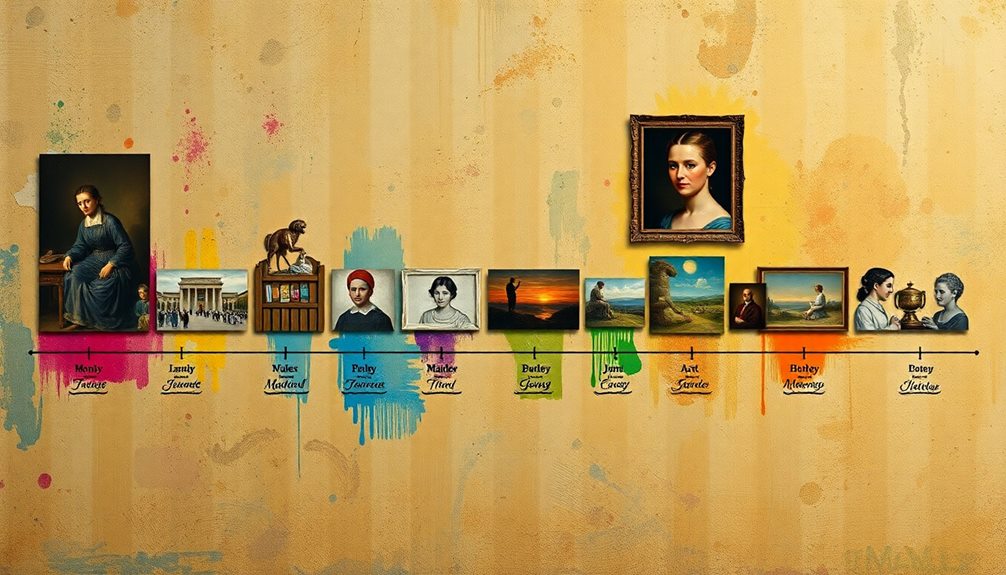
Art periods serve as a fascinating lens through which you can explore the evolution of artistic styles and their cultural significance. Each art period reflects the unique cultural, social, and political contexts of its time, offering a rich history of art that spans from Prehistoric to Contemporary art.
By examining the art movements timeline, you'll see how techniques and themes have transformed over centuries. The Renaissance, for example, marked a pivotal shift towards realism and humanism, showcasing the beauty of the human form and nature through the works of influential artists.
Later, Impressionism emerged, capturing fleeting moments and light, before transitioning into Post-Impressionism, where artists began to delve into deeper emotional themes and symbolic meanings.
Modern art followed, breaking traditional boundaries and experimenting with form and content. Today, Contemporary art continues this trend, showcasing diverse mediums while addressing pressing issues like identity and politics in a global context.
Understanding these art periods isn't just about appreciating aesthetics; it's about grasping the powerful narratives that shape our world through creativity.
Key Concepts and Definitions
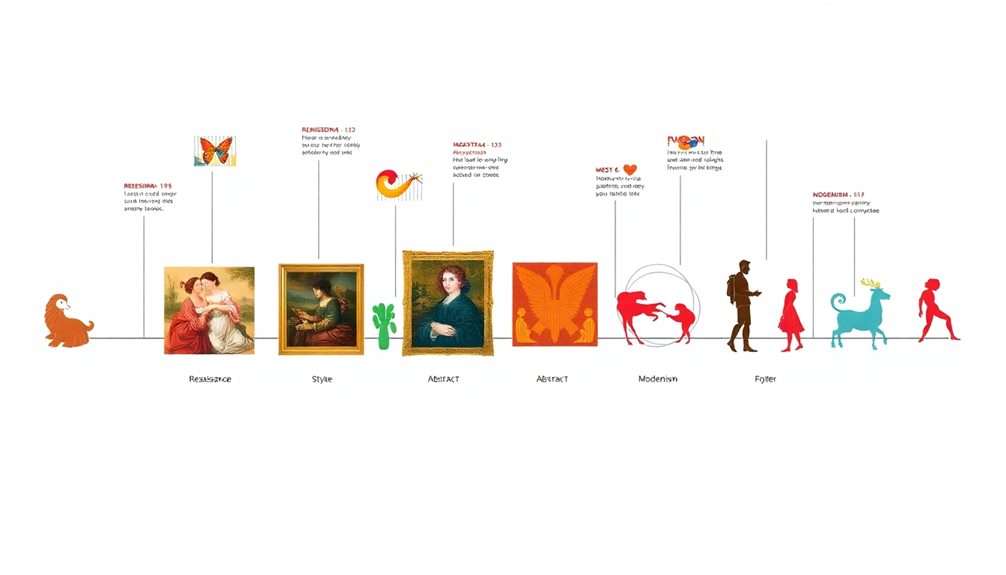
Understanding the key concepts and definitions related to art periods helps clarify the complexities of artistic evolution. Art periods are defined phases that showcase the evolution of artistic styles and movements, reflecting the cultural contexts, social dynamics, and political climates of their times.
The timeline of art is chronological, with historical art periods such as the Renaissance and Baroque influencing subsequent artistic expression. Major movements, including Romanticism, Realism, and Impressionism, highlight how artists responded to their environments, leading to Modern movements like Cubism and Surrealism. These movements not only represent shifts in technique but also changes in thought and perception.
Contemporary art, emerging from the late 20th century, is marked by diverse mediums and conceptual approaches, tackling current social issues and global influences. Understanding these art periods and their overlaps is essential, as it helps you appreciate the continuity and dialogue between historical and contemporary artistic practices.
Art Movement Characteristics Explained
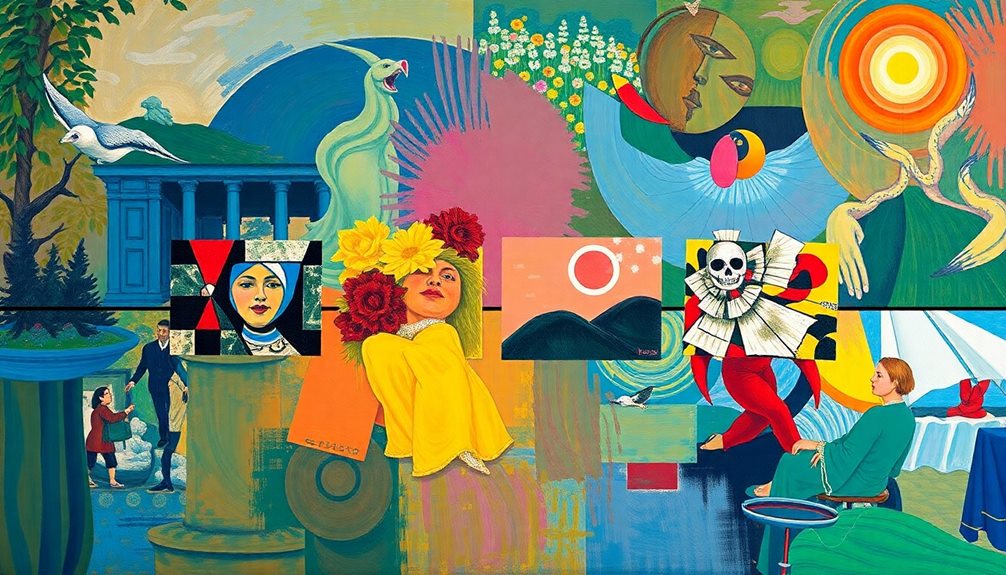
Throughout history, various art movements have emerged, each with distinct characteristics that reflect the cultural and societal shifts of their time.
Prehistoric Art, dating back to around 40,000–4,000 B.C., employed natural pigments to create cave paintings and rock carvings, focusing on survival themes and spirituality through symbolic imagery.
Moving forward, Renaissance Art (1400–1600) introduced humanism and realism, utilizing techniques like linear perspective and chiaroscuro to depict the human form's beauty and complexity.
Then came Impressionism (1865–1885), which broke away from traditional artistic norms. Impressionists captured fleeting moments with spontaneous brush strokes and vibrant colors, emphasizing the effects of light, as seen in Claude Monet's iconic "Impression, Sunrise."
In stark contrast, Dadaism (1916–1920) emerged as a reaction to World War I, challenging established artistic norms through absurdity and anti-art sentiments, exemplified by Marcel Duchamp's provocative "Fountain."
Each movement not only reflects the artistic innovations of its time but also serves as a mirror to the societal values and cultural contexts that shaped them.
Understanding these characteristics helps you appreciate the evolution of art throughout history.
Famous Artworks as Case Studies
Famous artworks serve as powerful case studies that highlight the distinct characteristics of various art movements. Famous artworks serve as powerful case studies that highlight the distinct characteristics of various art movements. For instance, Renaissance pieces often emphasize perspective and realism, showcasing the period’s focus on humanism and scientific precision. Meanwhile, abstract works delve into the exploration of elements such as color, line, and space in formalist art theory, stripping away representational content to focus purely on form and composition. These diverse approaches reflect how art evolves in response to cultural, philosophical, and technological changes.
Take Leonardo da Vinci's "Mona Lisa," for example. This Renaissance masterpiece showcases realism and human emotion, employing techniques like sfumato to create depth in her enigmatic expression.
Moving into the realm of Impressionism, Claude Monet's "Impression, Sunrise" captures the transient effects of light with loose brushwork and vibrant colors, immersing you in a sensory experience.
In contrast, Pablo Picasso's "Les Demoiselles d'Avignon" marks the birth of Cubism, presenting fragmented figures and multiple perspectives that challenge traditional representations of space.
Vincent van Gogh's "Starry Night" is a quintessential Post-Impressionist painting, using swirling brushstrokes and a vivid palette to convey emotional intensity and movement in the night sky.
Lastly, Salvador Dalí's "The Persistence of Memory" illustrates the dreamlike quality of Surrealism, featuring melting clocks that explore themes of time and reality, reflecting the fluidity of the subconscious mind.
Tips and Best Practices
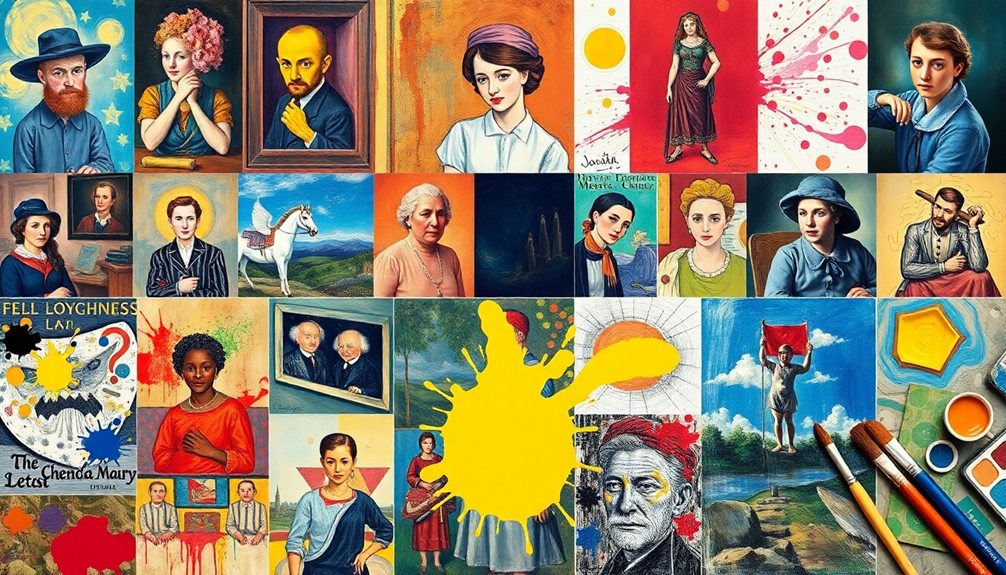
To appreciate the richness of art periods, it helps to adopt certain strategies that enhance your learning experience. Start by familiarizing yourself with the key characteristics and themes of each art period. For example, understand the emphasis on nature in the Hudson River School and the break from tradition seen in Modern Art Movements like Impressionism and Cubism.
Create a chronological timeline to visualize the progression of art movements, noticing how each period reacts to and influences the preceding styles. Consider how Romanticism set the stage for Realism.
Dive into the lives and contributions of notable artists—like Claude Monet's role in Impressionism and Pablo Picasso's impact on Cubism—to grasp individual influences on broader movements.
Utilize resources such as art history books, museum exhibitions, and online platforms to explore exemplary works. This exposure enhances your comprehension of their unique features and societal contexts.
Audience Engagement and Feedback
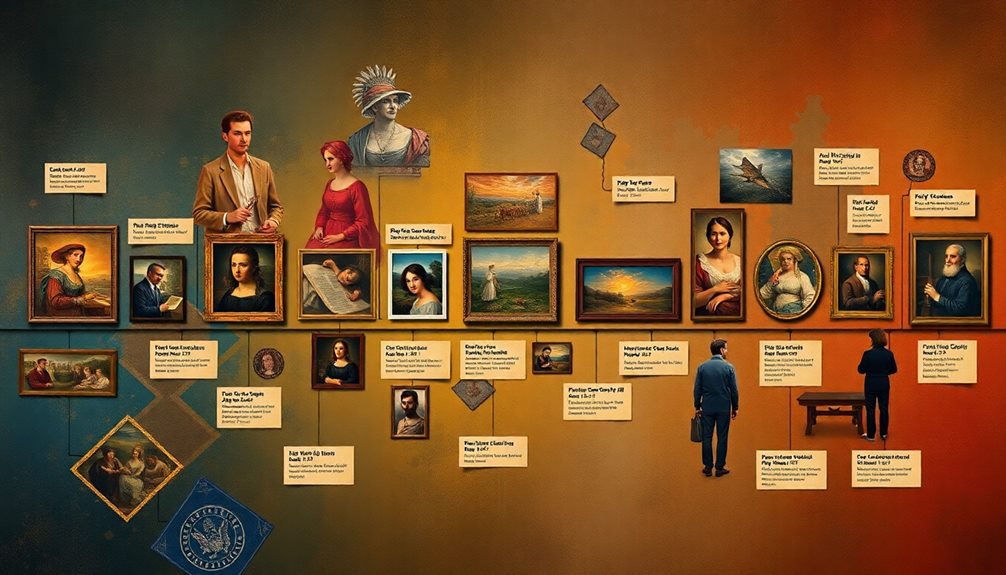
Art enthusiasts' engagement plays a crucial role in deepening their appreciation of various art periods. By participating in interactive exhibits and utilizing social media platforms, you can enhance your understanding of art history and receive real-time feedback. This dynamic interaction allows curators to tailor presentations based on your interests and knowledge levels, making the experience more relevant.
Incorporating audience feedback through surveys and polls during art events helps gauge your reactions and preferences. This information informs future programming, ensuring it resonates with attendees.
Additionally, hosting artist talks and panel discussions fosters deeper engagement, enabling you to ask questions and share insights about specific movements and their contemporary relevance.
Moreover, creating online resources such as podcasts and webinars encourages ongoing learning, giving you access to information about art periods beyond traditional gallery visits. These resources support continuous audience engagement, allowing you to explore art history at your own pace.
Embracing these opportunities not only enriches your experience but also contributes to a vibrant art community where feedback and interaction drive the evolution of exhibitions and educational initiatives.
Cultural Context and Interpretation
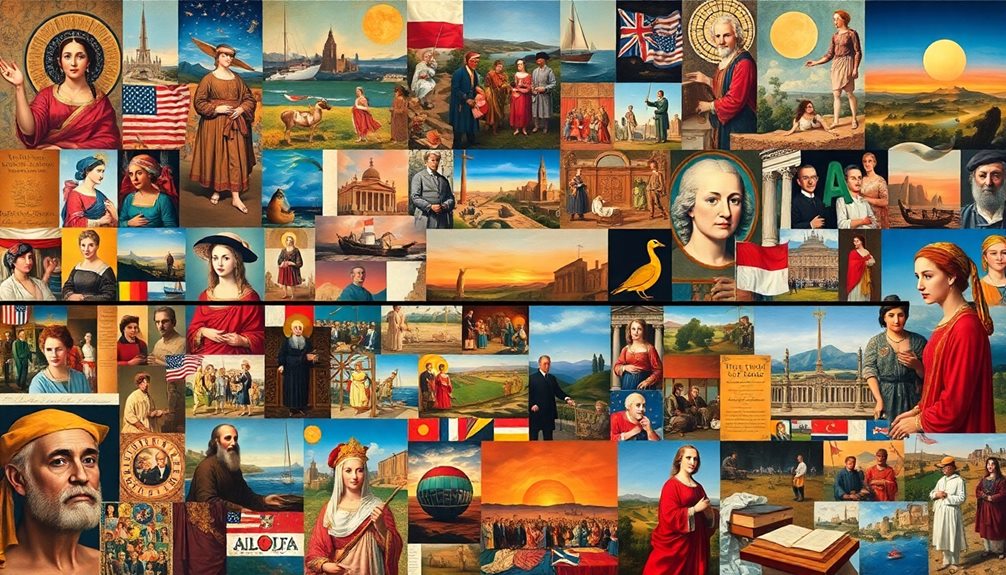
Understanding an art period's cultural context is essential for interpreting its significance and meaning. Art periods aren't just about stylistic changes; they reflect the socio-political environments and cultural movements of their time.
For instance, during the Renaissance period, a revival of classical ideals emphasized individualism and humanism, largely influenced by the rediscovery of ancient texts. Similarly, the Romantic movement arose as a response to the Enlightenment, focusing on emotional expression and the sublime as society shifted towards personal interpretation of nature.
In contemporary art, you'll notice a reflection of global issues like identity and politics, shaped by the interconnectedness of cultures in our globalized world. Each art movement can be seen as a reaction to its predecessors, showcasing artistic evolution.
For example, Impressionism laid the groundwork for Post-Impressionism, where artists critiqued and expanded upon earlier expressions. By exploring these connections, you gain a deeper understanding of how each art period not only represents its time but also interacts with the cultural currents around it.
This insight is crucial for appreciating the layers of meaning embedded in artworks throughout history.
Additional Resources
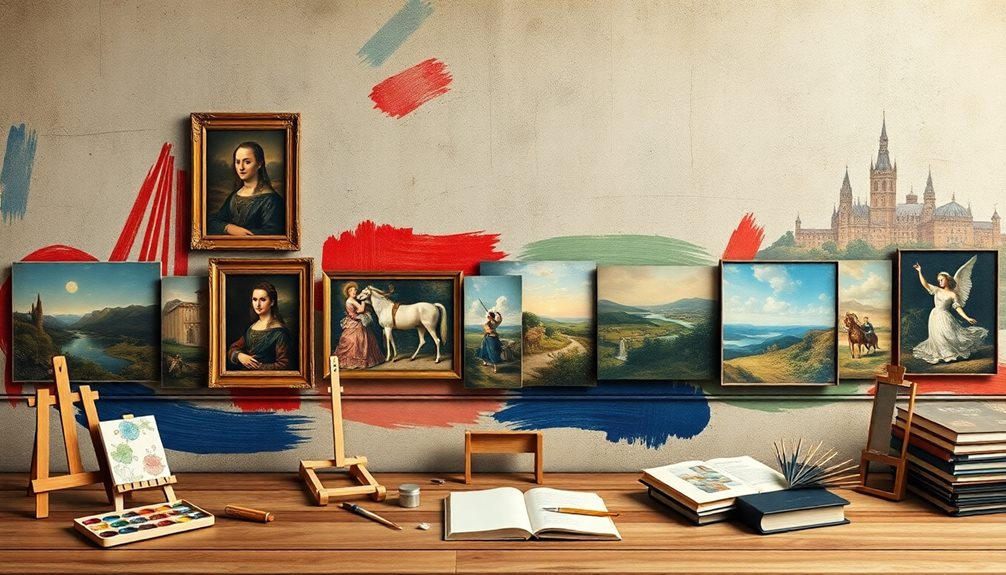
A wealth of resources is available to deepen your knowledge of art periods and movements. Websites like Tate.org offer extensive information on global art movements, artist biographies, and thematic exhibitions, making it a go-to resource for understanding various art styles and emotional themes.
Wikipedia.org provides a comprehensive art history timeline that includes overviews of art movements and notable figures, perfect for quick reference.
For a more in-depth exploration, TheArtStory.org features detailed articles on individual art movements and key artists, enhancing your understanding of how these periods evolved. Art history textbooks are also invaluable, often containing timelines, critical analyses, and visual examples essential for both academic study and personal exploration.
If you prefer structured learning, consider enrolling in online courses or lectures on platforms like Coursera or Khan Academy. These resources cover the history of art movements and their cultural contexts, helping you grasp the significance of Western art and its impact.
Frequently Asked Questions
What Are the 6 Time Periods in the Art History Timeline in the Correct Order?
You'll find the six major art periods in this order: Prehistoric Art, Ancient Art, Medieval Art, Renaissance Art, Baroque and Rococo Art, and Modern Art. Each period reflects unique styles and cultural advancements.
What Are the Different Time Periods of Art?
Art history features various time periods, including Prehistoric, Ancient, Medieval, Renaissance, and Modern. Each period showcases unique styles and themes, reflecting cultural shifts and artistic innovations that influence how you perceive art today.
What Does Period Mean in Art History?
In art history, a period refers to a distinct phase marked by unique styles, techniques, and themes. It reflects the cultural and social context, helping you appreciate the evolution of artistic expression over time.
What Is the Timeline of the Modern Art Period?
The modern art period stretches from the late 19th century to the mid-20th century. You'll see key movements like Impressionism, Post-Impressionism, and Cubism, each reshaping artistic expression and challenging traditional conventions.
Conclusion
In summary, understanding art periods enriches your appreciation of creativity and culture. By exploring different movements and their unique characteristics, you can connect deeper with famous artworks and their historical contexts. Remember to engage with art actively, ask questions, and share your thoughts with others. Don't forget to utilize the additional resources provided to further enhance your knowledge. Embrace the journey of discovery in the world of art—it's a rewarding experience you won't want to miss!








